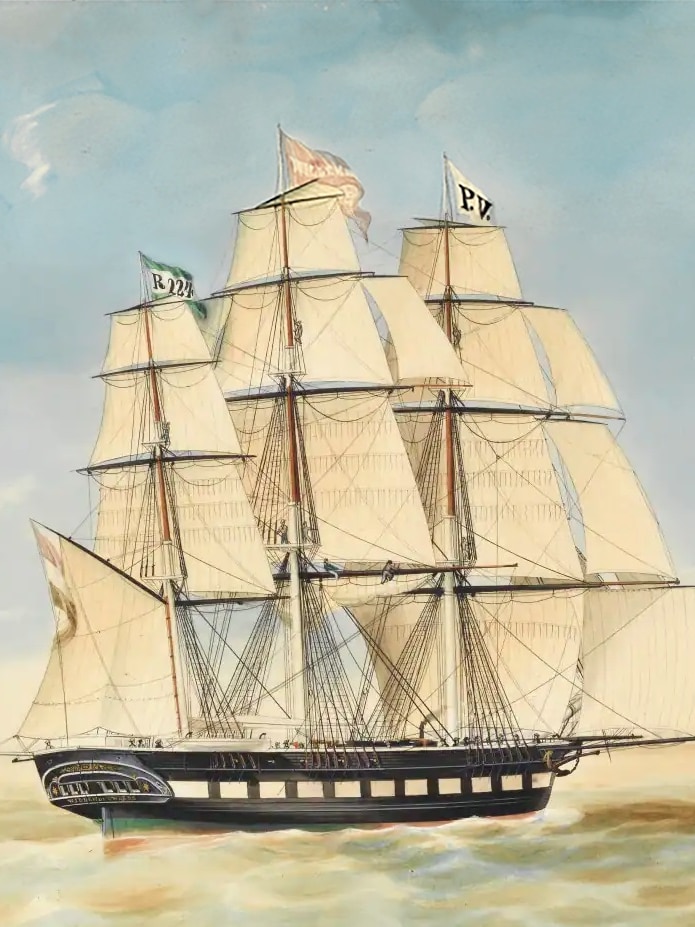Residents of a town in South Australia’s south-east are being enlisted in research into a shipwreck that killed 16 Dutch sailors in 1857 soon after offloading 400 gold miners from China.
More scrutiny is also on objects thought to have come from the shipwreck of the Koning Willem de Tweede that actually may have been from other shipwrecks.
On June 30, 1857, the Koning Willem de Tweede (King William II) was run aground on Robe’s Long Beach during a storm by a captain trying to save it.
Instead, the Dutch ship was “beaten to matchsticks”, according to James Hunter, who is leading a project researching the disaster.
Dr Hunter, curator of naval heritage and archaeology at the Australian National Maritime Museum in Sydney, said the waves that hit it might have been up to six metres high.
“These waves were smashing into this ship repeatedly and it was a timber vessel,” he said.
“It was old — by this point it had been around for several years — so it didn’t take long for it to start to break apart.”
Dr Hunter and conservator Heather Berry were part of a team that found what appears to be the site of the shipwreck off Long Beach in 2022.
It is buried in metres of sand and has not yet been reached by divers.
Objects washed up from ship
The ship had come to Robe from Hong Kong so the Chinese gold miners on board could avoid a tax on immigrants arriving by sea in Victoria.
Because the wreck happened so quickly — in perhaps about half an hour — very little was removed from the ship, with the focus instead on saving the crew.
However, Dr Hunter and Ms Berry, from the Silentworld Foundation which funds research into maritime archaeology and heritage, believe many items from the ship would have washed up on Long Beach since.
“There’s a lot of ceramics that have washed up over the years, glass and of course bits of the ship itself – maybe parts that were being used or maybe other parts that were being stored in case of need for repairs,” Ms Berry said.
Advice on conservation
Ms Berry has put together a booklet about how to conserve items people find from shipwrecks that applies particularly to Robe but also to other places around Australia.
Crockery is commonly found but Ms Berry said it could disintegrate if it was not looked after properly after being under water for sometimes hundreds of years.
“If you don’t desalinate them properly then you will lose the glaze because, as the salt recrystallises, it just pops off that glaze,” she said.
“It’s quite impressive to actually look at – I’ve seen a few examples of it – but it is ultimately sad because you’ve lost that information.”
The booklet is being launched in Robe today with a workshop on the same topic planned for tomorrow at the Robe Customs House Maritime Museum.
People can bring in objects they have found for advice on conserving, which Dr Hunter and Ms Berry can examine to determine historical value.
Connections to today
A bell believed to have come from the ship was rung at Robe Primary School from its founding in 1886 until about 15 years ago to bring students in from lunch and recess.
A replica now stands in its place with the original in the local maritime museum.
If Dr Hunter is not completely sure the bell came from the Koning Willem de Tweede he is very sceptical about a cannon near the museum overlooking Town Beach and an arch commemorating the Chinese migrants of the 1850s.
Because of its British design, he thinks it may have come from another ship wrecked near Robe in 1857, the Sultana.
“There’s all sorts of things that suggest it could well have been — but maybe not — so the first thing I’d really like to do is nail down where that stuff came from — the things that we already know about,” he said.
Building Dutch relations
Most of the funding for the project comes from the Dutch government as part of a push by the Netherlands to strengthen ties with Australia.
The Dutch embassy’s cultural attaché, Xenia Hanusiak, said the ship was one of five or six Dutch commercial ships that brought Chinese to Australia at the time.
She said many Australians knew about the Dutch East India Company ships that wrecked in Western Australia in the 1600s but the later history was less well known.
“Even though the Dutch had been travelling by happenstance in the 17th century to the shores and some of the boats were shipwrecked, this we would see as an example of when the Dutch perhaps became interested in settling in Australia for mercantile benefits,” Ms Hanusiak said.
While in Robe, Dr Hunter and Ms Berry also visited the old police stables handed over to the National Trust six years ago to look at how objects there could be preserved.
Robe National Trust branch secretary Valerie Monaghan said it was good to have them in town.
“People with metal detectors still pick up things on Long Beach and it’s really important that we keep track of what’s found and keep the things that are really worth keeping,” she said.
Researchers plan to return to Robe next summer to use more techniques to look into the wreck, including probing, using metal detectors and fanning (waving sand away with the hands).
Get our local newsletter, delivered free each Friday
Posted , updated




